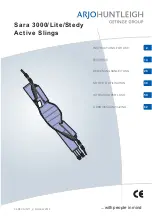
19
SD
Card
Functions
The
petMAP
g
II
contains
an
SD
card
slot
which
can
be
used
to
automatically
record
all
vital
signs
data
on
a
user
supplied
SD
card
for
archiving
directly
to
the
SD
card
and
for
optionally
transferring
to
a
PC/MAC
for
long
term
storage,
display
and/or
printing.
The
SD
card
can
also
optionally
record
an
image
of
the
screen
at
any
time
that
a
BP
determination
is
not
in
progress
by
pressing
the
“Save
Screen”
button
and/or
by
responding
to
the
prompt
at
the
time
the
unit
is
switched
OFF
by
the
user.
To
use
these
SD
card
storage
functions
a
2,
4,
8
or
16
GB
SD
card
must
be
properly
inserted
into
the
SD
card
slot.
The
card
must
be
inserted
with
the
card
label
facing
up
when
the
unit
is
being
viewed
normally
and
pressed
firmly
into
the
slot
such
that
it
is
entirely
within
the
slot
and
no
portion
is
protruding
from
the
side
of
the
petMAP
g
II
device.
To
remove
the
card,
press
it
firmly
further
into
the
slot
and
then
release
pressure
and
the
card
will
eject
automatically.
The
mechanical
function
of
the
SD
card
in
the
petMAP
g
II
is
the
same
as
in
cameras
that
use
SD
cards
for
picture
storage
and
will
be
familiar
to
most
users.
It
is
important
to
note
if
using
a
2
GB
SD
card,
it
can
only
accommodate
512
files
on
a
card
or
errors
will
occur.
For
a
4
GB
card,
only
1024
files
can
be
written
on
it
or
the
same
errors
will
be
created.
Should
this
happen,
the
SD
card
must
be
removed
and
some
number
of
data
or
image
files
erased
or
a
new
SD
card
used
in
its
place.
If
there
is
difficulty
after
changing
the
SD
card,
it
is
possible
that
the
petMAP
g
II
must
be
hard
powered
OFF
(by
holding
the
ON/OFF
button
down
for
10
seconds,
followed
by
a
new
power
ON
button
press)
or
the
unit
will
not
function.
For
8
and
16
GB
cards,
there
are
many
more
files
available,
but
writing
time
will
be
longer
than
with
the
smaller
SD
card
sizes,
particularly
when
using
a
16
GB
card.
Checking
the
available
files
on
the
SD
card
is
easily
done
at
the
same
time
as
when
copying
data
from
the
SD
card
to
a
PC/MAC.
For
many
users,
this
restriction
on
the
number
of
files
with
a
2
or
4
GB
card
will
not
be
a
problem
if
the
SD
card
is
replaced
every
year.
However,
if
the
device
is
used
in
an
active
clinic
or
very
active
OR
setting
and
2
monitoring
sessions
are
done
each
week
day
and
the
screen
image
is
saved
each
time…
in
a
year
of
use,
there
would
be
too
many
files
for
even
the
4
GB
SD
card
to
hold
the
data,
ie:
260
days
X
2
sessions/day
X
2
files/session
=
1040
files,
and
thus
this
number
would
slightly
exceed
the
1024
allowable
file
count
on
a
4
GB
SD
card.
During
petMAP
g
II
use,
the
data
for
each
measurement
or
monitoring
session
is
automatically
captured
in
a
.TXT
file
(described
later
in
this
manual)
if
there
is
an
SD
card
in
the
unit.
The
screen
image
file
capture
(described
below)
is
enabled
by
the
user
either
by
pressing
the
“Save
Screen”
button
or
at
power
OFF
time.
Not
capturing
the
screen
image
allows
a
single
SD
card
to
last
longer
before
needing
replacement,
but
the
potential
usefulness
of
the
recorded
screen
image
will
be
lost.
It
is
suggested
that
if
recording
is
important
to
the
user’s
practice
that
SD
cards
be
checked
often
and
the
data
archived
on
a
PC/MAC
before
files
are
erased
on
the
SD
card
to
create
more
room
on
the
card.
Содержание petMAP graphic II 7300
Страница 1: ... Trademark of Ramsey Medical Inc ...
















































